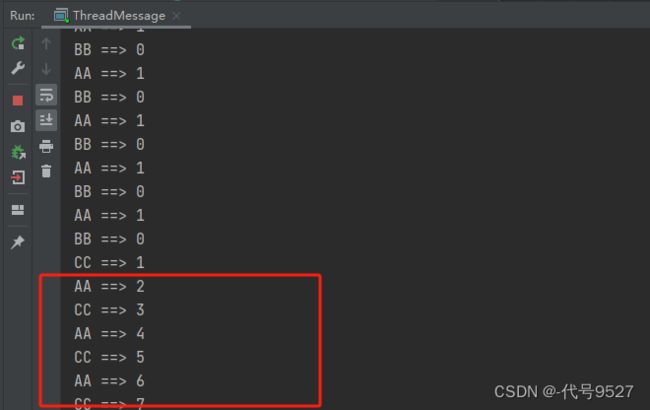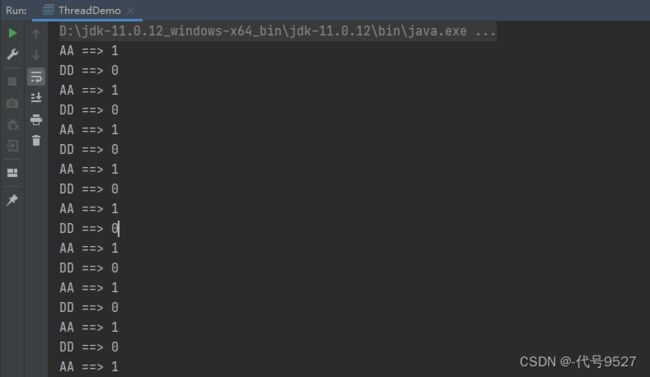【JUC】二、线程间的通信(虚假唤醒)
文章目录
- 0、多线程编程的步骤
- 1、wait和notify
- 2、synchronized下实现线程的通信(唤醒)
- 3、虚假唤醒
- 4、Lock下实现线程的通信(唤醒)
- 5、线程间的定制化通信
0、多线程编程的步骤
- 步骤一:创建(将来被共享的)资源类,创建属性和操作方法
- 步骤二:在资源类的操作方法中进行:判断、干活儿、通知
- 步骤三:创建多线程调用资源类的方法
- 步骤四:防止虚假唤醒现象
1、wait和notify
- wait 和notify方法是任何一个Java对象都有的方法,因为这两个方法是Object类的方法
- wait方法让正在o对象上活动的线程进入等待状态,
并释放o对象的对象锁,直到被唤醒为止
Object o = new Object();
o.wait();
//public final void wait(long timeout)
//timeout是要等待的最长时间
- 注意是正在o对象上活动的线程,而不是线程对象,所以别t.wait
- notify方法,唤醒在此对象上等待的单个线程,如果此对象上有多个线程在等待,那就随机唤醒一个线程。直到当前线程放弃此对象上的锁定,这个被唤醒的线程才能继续执行,且如果该对象上还有其他主动同步的线程,则被唤醒的线程要与它们进行竞争,如果该对象上就这一个线程(刚被唤醒的线程),那就自然是它抢到对象锁
- notifyAll,即唤醒该对象上等待的所有线程,和notify一样,也是等当前线程释放占用的对象锁后,再竞争、执行
Object的wait()与Thread.sleep()的区别:
- Thread.sleep()是让当前线程
拿着锁睡眠指定时间,时间一到手里拿着锁自动醒来,还可以接着往下执行 - Object的wait则是
睡前释放锁,只有当前锁对象调用了notify或者notifyAll方法才会醒来(不考虑wait带参数指定睡眠时间),且醒来手里也没锁,得再竞争,也就是说wait的线程被唤醒是就绪状态
2、synchronized下实现线程的通信(唤醒)
案例:启动两个线程,实现对同一个数交替的加1和减1操作
//资源类
class Share{
//初始值
private int number = 0;
//+1
public synchronized void incr() throws InterruptedException {
if(number != 0){
this.wait(); //让share对象上的线程等待
}
number++;
System.out.println(Thread.currentThread().getName() + " ==> " + number);
//通知其他线程
this.notify();
}
//-1
public synchronized void decr() throws InterruptedException {
if(number != 1){
this.wait();
}
number--;
System.out.println(Thread.currentThread().getName() + " ==> " + number);
this.notify();
}
}
启动多线程,共用资源类对象,调用资源类的方法:
public class ThreadMessage {
public static void main(String[] args) {
Share share = new Share();
new Thread(() -> {
for(int i = 0; i <= 10 ; i++){
try {
share.incr(); //+1
} catch (InterruptedException e) {
e.printStackTrace();
}
}
},"AA").start();
new Thread(() -> {
for(int i = 0; i <= 10 ; i++){
try {
share.decr(); //-1
} catch (InterruptedException e) {
e.printStackTrace();
}
}
},"BB").start();
}
}
3、虚假唤醒
上面的代码改为4个线程对同一个数字进行操作,其中AA、CC负责加一,BB、DD负责减一:
public class ThreadMessage {
public static void main(String[] args) {
Share share = new Share();
new Thread(() -> {
for(int i = 0; i <= 10 ; i++){
try {
share.incr(); //+1
} catch (InterruptedException e) {
e.printStackTrace();
}
}
},"AA").start();
new Thread(() -> {
for(int i = 0; i <= 10 ; i++){
try {
share.decr(); //-1
} catch (InterruptedException e) {
e.printStackTrace();
}
}
},"BB").start();
new Thread(() -> {
for(int i = 0; i <= 10 ; i++){
try {
share.incr(); //+1
} catch (InterruptedException e) {
e.printStackTrace();
}
}
},"CC").start();
new Thread(() -> {
for(int i = 0; i <= 10 ; i++){
try {
share.decr(); //-1
} catch (InterruptedException e) {
e.printStackTrace();
}
}
},"DD").start();
}
}
执行发现有非0非1的数值出现:
发生这个错误的原因是,wait方法的特点是在哪一行睡,就在哪一行醒,然后接着往下执行,这就导致了wait前面的判断条件只有第一次生效,这就是虚假唤醒。画个草图:
注意,这里可能还有一个因唤醒不当而导致阻塞的情况,多次运行会出现:光标闪烁,但没有输出,也没有exit 0。这个后面篇章再整理。
对于虚假唤醒的解决办法就是把if换成while,即在循环中使用,此时睡醒接着往下执行也会先判断一下。
//资源类
class Share{
//初始值
private int number = 0;
//+1
public synchronized void incr() throws InterruptedException {
while(number != 0){ //改为while
this.wait(); //让share对象上的线程等待
}
number++;
System.out.println(Thread.currentThread().getName() + " ==> " + number);
//通知其他线程
this.notify();
}
//-1
public synchronized void decr() throws InterruptedException {
while(number != 1){ //改为while
this.wait();
}
number--;
System.out.println(Thread.currentThread().getName() + " ==> " + number);
this.notify();
}
}
虚假唤醒不再出现:
结论:wait方法可能出现虚假唤醒,应该在循环中调用wait方法
synchronized (obj) {
while (<condition does not hold>){
obj.wait(timeout);
... // Perform action appropriate to condition
}
}
4、Lock下实现线程的通信(唤醒)
Lock代替了synchronized,Condition接口替代Object类的wait、notify等监视器方法。Lock接口下的重要方法:
- newCondition():返回绑定到此 Lock 实例的新 Condition 实例
- await方法类比Object的wait
- signal():唤醒一个等待线程
- signalAll():唤醒所有等待线程
接下来用Lock接口实现上面synchronized的案例,对同一个数字进行加减1:
class ShareObj{
private int number = 0;
//创建Lock,用可重复锁的实现类
Lock lock = new ReentrantLock();
private Condition condition = lock.newCondition();
public void incr() throws InterruptedException {
//上锁
lock.lock();
try {
//判断
while(number != 0){
condition.await();;
}
//干活儿
number++;
System.out.println(Thread.currentThread().getName() + " ==> " + number);
//通知
condition.signalAll();
} finally {
//解锁
lock.unlock();
}
}
public void decr() throws InterruptedException {
lock.lock();
try {
//判断
while(number != 1){
condition.await();;
}
//干活儿
number--;
System.out.println(Thread.currentThread().getName() + " ==> " + number);
//通知
condition.signalAll();
} finally {
lock.unlock();
}
}
}
启动多线程调用资源类方法:
public class ThreadDemo {
public static void main(String[] args) {
ShareObj shareObj = new ShareObj();
new Thread(() -> {
for(int i = 0; i <= 10; i++ ){
try {
shareObj.incr();
} catch (InterruptedException e) {
e.printStackTrace();
}
}
},"AA").start();
new Thread(() -> {
for(int i = 0; i <= 10; i++ ){
try {
shareObj.decr();
} catch (InterruptedException e) {
e.printStackTrace();
}
}
},"BB").start();
new Thread(() -> {
for(int i = 0; i <= 10; i++ ){
try {
shareObj.incr();
} catch (InterruptedException e) {
e.printStackTrace();
}
}
},"CC").start();
new Thread(() -> {
for(int i = 0; i <= 10; i++ ){
try {
shareObj.decr();
} catch (InterruptedException e) {
e.printStackTrace();
}
}
},"DD").start();
}
}
5、线程间的定制化通信
可以看到,前面的例子中,AA线程执行完后,共享的那把对象锁被谁抢到,或者说接下来是哪个线程执行,这一点是随机的。这里要实现的就是将这个通信变成定制化的。案例:
启动三个线程,按照如下顺序运行:
- AA线程打印5次,BB打印10次,CC打印15次
- ...
- 进行10轮这个打印
实现思路是给每一个线程引入一个标志位flag变量:
代码实现:
//定义资源类
class ShareSource {
//定义标志位,AA线程对应1,BB对应2,CC对应3
private Integer flag = 1;
//创建Lock锁
private Lock lock = new ReentrantLock();
//创建三个condition
private Condition c1 = lock.newCondition();
private Condition c2 = lock.newCondition();
private Condition c3 = lock.newCondition();
/**
* 打印5次
* @param loop 第几轮
*/
public void print5(int loop) throws InterruptedException {
//上锁
lock.lock();
try{
//判断
while(flag != 1){
c1.await();
}
//干活,fori快捷生成
for (int i = 0; i < 5; i++) {
System.out.println(Thread.currentThread().getName() + "==>" + i + ",第"+ loop + "轮");
}
//改标志位并通知BB
flag = 2;
c2.signal();
}finally {
//解锁
lock.unlock();
}
}
/**
* 打印10次
* @param loop 第几轮
*/
public void print10(int loop) throws InterruptedException {
//上锁
lock.lock();
try{
//判断
while(flag != 2){
c2.await();
}
//干活fori快捷生成
for (int i = 0; i < 10; i++) {
System.out.println(Thread.currentThread().getName() + "==>" + i + ",第"+ loop + "轮");
}
//改标志位并通知CC
flag = 3;
c3.signal();
}finally {
//解锁
lock.unlock();
}
}
/**
* 打印15次
* @param loop 第几轮
*/
public void print15(int loop) throws InterruptedException {
//上锁
lock.lock();
try{
//判断
while(flag != 3){
c3.await();
}
//干活fori快捷生成
for (int i = 0; i < 15; i++) {
System.out.println(Thread.currentThread().getName() + "==>" + i + ",第"+ loop + "轮");
}
//改标志位并通知AA
flag = 1;
c1.signal();
}finally {
//解锁
lock.unlock();
}
}
}
启动多线程,调用资源类中的方法:
public class ThreadDemoTwo {
public static void main(String[] args) {
ShareSource shareSource = new ShareSource();
new Thread(() -> {
for (int i = 1; i <= 10; i++) {
try {
shareSource.print5(i);
} catch (InterruptedException e) {
e.printStackTrace();
}
}
},"AA").start();
new Thread(() -> {
for (int i = 1; i <= 10; i++) {
try {
shareSource.print10(i);
} catch (InterruptedException e) {
e.printStackTrace();
}
}
},"BB").start();
new Thread(() -> {
for (int i = 1; i <= 10; i++) {
try {
shareSource.print15(i);
} catch (InterruptedException e) {
e.printStackTrace();
}
}
},"CC").start();
}
}
运行:







